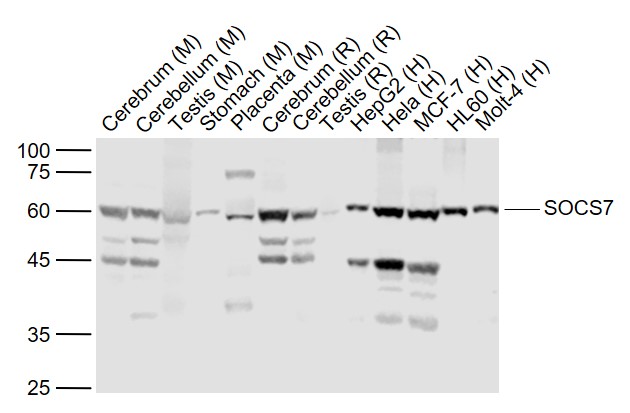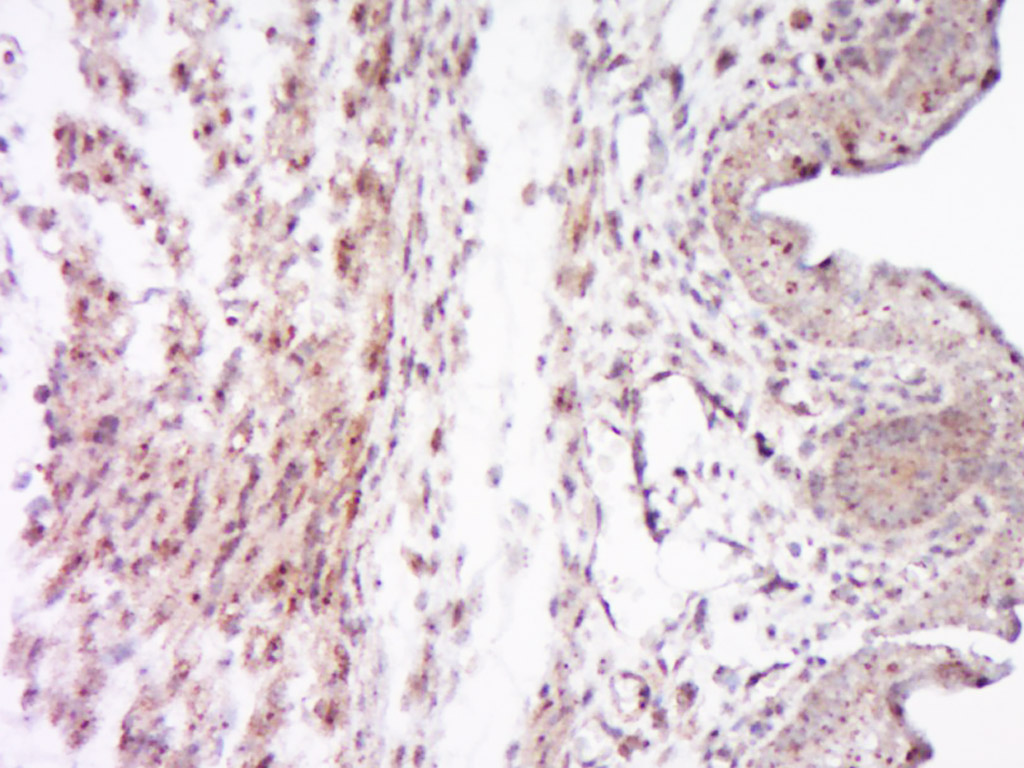
Rabbit Anti-SOCS7 antibody
NAP 4; NAP 4 Fragment; NAP4; Nck Ash and phospholipase C binding protein; Nck Ash and phospholipase C gamma binding protein; Nck associated protein 4; NCKAP4; SH2 domain containing SOCS box protein; SOCS 7; SOCS4; SOCS6; Suppressor of cytokine signaling 7
View History [Clear]
Details
Product Name SOCS7 Chinese Name Signal transduction和转录激活因子7抗体 Alias NAP 4; NAP 4 Fragment; NAP4; Nck Ash and phospholipase C binding protein; Nck Ash and phospholipase C gamma binding protein; Nck associated protein 4; NCKAP4; SH2 domain containing SOCS box protein; SOCS 7; SOCS4; SOCS6; Suppressor of cytokine signaling 7;SOCS7_HUMAN. literatures Research Area Cell biology immunology Signal transduction lymphocyte Immunogen Species Rabbit Clonality Polyclonal React Species Human, Mouse, Rat, (predicted: Rabbit, ) Applications WB=1:500-2000 ELISA=1:5000-10000 IHC-P=1:100-500 IHC-F=1:100-500 ICC=1:100-500 IF=1:100-500 (Paraffin sections need antigen repair)
not yet tested in other applications.
optimal dilutions/concentrations should be determined by the end user.Theoretical molecular weight 63kDa Cellular localization cytoplasmic The cell membrane Form Liquid Concentration 1mg/ml immunogen KLH conjugated synthetic peptide derived from human SOCS7: 171-270/581 Lsotype IgG Purification affinity purified by Protein A Buffer Solution Preservative: 15mM Sodium Azide, Constituents: 1% BSA, 0.01M PBS, pH 7.4 Storage Shipped at 4℃. Store at -20 °C for one year. Avoid repeated freeze/thaw cycles. Attention This product as supplied is intended for research use only, not for use in human, therapeutic or diagnostic applications. PubMed PubMed Product Detail The eight members of the recently identified Suppressor of Cytokines Signaling (SOCS) family are SOCS1, SOCS2, SOCS3, SOCS4, SOCS5, SOCS6, SOCS7, and CIS. Structurally the SOCS proteins are composed of an N- terminal region of variable length and amino acid composition, a central SH2 domain, and a C-terminal motif called the SOCS box. The SOCS proteins appear to form part of a classical negative feedback loop that regulates cytokine signal transduction. Transcription of each of the SOCS genes occurs rapidly in vitro and in vivo in response to cytokines, and once produced, the various members of the SOCS family appear to inhibit signaling in different ways. SOCS1 and SOCS6 interact with the insulin receptor (IR) when expressed in human hepatoma cells (HepG2) or in rat hepatoma cells overexpressing human IR. SOCS1 and SOCS6 inhibit insulin-dependent activation of ERK1/2 and protein kinase B in vivo and IR- directed phosphorylation of IRS1 in vitro. These results suggest that SOCS proteins may be inhibitors of IR signalling and could mediate cytokine-induced insulin resistance and contribute to the pathogenesis of type II diabetes. SOCS6 and SOCS7 are expressed ubiquitously in murine tissues and SOCS6 knockout mice are growth retarded.
Function:
Regulates signaling cascades probably through protein ubiquitination and/or sequestration. Functions in insulin signaling and glucose homeostasis through IRS1 ubiquitination and subsequent proteasomal degradation. Inhibits also prolactin, growth hormone and leptin signaling by preventing STAT3 and STAT5 activation, sequestering them in the cytoplasm and reducing their binding to DNA. May be a substrate recognition component of a SCF-like E3 ubiquitin-protein ligase complex which mediates the ubiquitination and subsequent proteasomal degradation of target proteins.
Subunit:
Interacts with phosphorylated IRS4 and PIK3R1 (By similarity). Interacts, via the third proline-rich region, with the second SH3 domain of the adapter protein NCK1. Also interacts with GRB2, INSR, IRS1, PLCG1, SORBS3/vinexin, and phosphorylated STAT3 and STAT5. Interacts with SEPT6.
Subcellular Location:
Cytoplasm. Cell membrane; Peripheral membrane protein; Cytoplasmic side. Nucleus. Note=Mostly cytoplasmic, but shuttles between the cytoplasm and the nucleus. Rapidly relocalizes to the nucleus after UV irradiation. Cytoplasmic location depends upon SEPT7 presence.
Tissue Specificity:
Expressed in brain and leukocytes. Also in fetal lung fibroblasts and fetal brain.
Similarity:
Contains 1 SH2 domain.
Contains 1 SOCS box domain.
SWISS:
O14512
Gene ID:
30837
Database links:Entrez Gene: 30837 Human
Omim: 608788 Human
SwissProt: O14512 Human
SwissProt: Q8WXH5 Human
Product Picture
Lane 1: Cerebrum (Mouse) Lysate at 40 ug
Lane 2: Cerebellum (Mouse) Lysate at 40 ug
Lane 3: Testis (Mouse) Lysate at 40 ug
Lane 4: Stomach (Mouse) Lysate at 40 ug
Lane 5: Placenta (Mouse) Lysate at 40 ug
Lane 6: Cerebrum (Rat) Lysate at 40 ug
Lane 7: Cerebellum (Rat) Lysate at 40 ug
Lane 8: Testis (Rat) Lysate at 40 ug
Lane 9: HepG2 (Human) Cell Lysate at 30 ug
Lane 10: Hela (Human) Cell Lysate at 30 ug
Lane 11: MCF-7 (Human) Cell Lysate at 30 ug
Lane 12: HL60 (Human) Cell Lysate at 30 ug
Lane 13: Molt-4 (Human) Cell Lysate at 30 ug
Primary:
Anti-SOCS7 (SL20151R) at 1/1000 dilution
Secondary: IRDye800CW Goat Anti-Rabbit IgG at 1/20000 dilution
Predicted band size: 63 kD
Observed band size: 60 kD
Tissue/cell: Mouse embryo tissue; 4% Paraformaldehyde-fixed and paraffin-embedded;
Antigen retrieval: citrate buffer ( 0.01M, pH 6.0 ), Boiling bathing for 15min; Block endogenous peroxidase by 3% Hydrogen peroxide for 30min; Blocking buffer (normal goat serum,C-0005) at 37℃ for 20 min;
Incubation: Anti-SOCS7 Polyclonal Antibody, Unconjugated(SL20151R) 1:500, overnight at 4°C, followed by conjugation to the secondary antibody(SP-0023) and DAB(C-0010) staining
Bought notes(bought amounts latest0)
No one bought this product
User Comment(Total0User Comment Num)
- No comment




 +86 571 56623320
+86 571 56623320
 +86 18668110335
+86 18668110335

